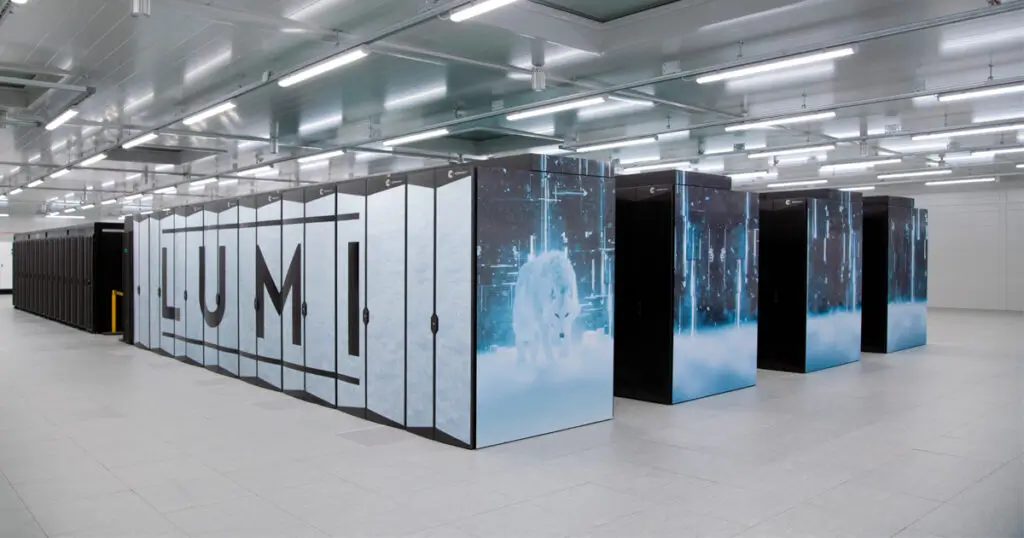Join the Destination Earth launch ceremony!
Margrethe Vestager, Executive Vice-president of the European Commission for a Europe Fit for the Digital Age will join representatives from the entities delivering Destination Earth to launch the second phase of the initiative.
The European Commission will mark the opening of the second phase of DestinE with an event at the LUMI EuroHPC supercomputer data center in Kajaani, Finland, on 10 June 2024. The launch event which will gather top representatives from the entities involved, their partner institutions and the EU Commission, will unveil the features of the first version of the DestinE information system, developed by the European Centre for Medium-Range Weather Forecasts (ECMWFEuropean Centre for Medium-Range Weather Forecasts More), the European Space Agency (ESA) and the European Organisation for the Exploitation of Meteorological Satellites (EUMETSAT).
Destination Earth, the ambitious initiative of the European Commission to create a digital replica of the Earth system, is ready to welcome its first users. Two years after the initiative started, ECMWFEuropean Centre for Medium-Range Weather Forecasts More, ESA, and EUMETSAT have already set up and brought together the key elements of the new information system.
With unprecedented levels of detail and including information for the sectors most affected by the impacts of climate change, DestinE will support adaptation and mitigation decision-making by enhancing our capacity to simulate climate change and weather-induced extremes, therefore, improving our response to the challenges our planet is facing in a warming climate.
The onsite event can be watched live on the EU Commission’s web page.

Representatives from the European Commission, key European and International stakeholders, the three entities implementing DestinE and their partner institutions, EuroHPC Joint Undertaking (EuroHPC JU) as well the Finish Government and the CSC IT Center for Science, which hosts the EuroHPC JU LUMIOne of the EuroHPC pre-exascale supercomputers, hosted and o More supercomputer will attend the event. CSC who is hosting the ceremony at its facilities in Finland, also leads on the development of the Climate Change Adaptation Digital Twin, in the framework of a contract procured by ECMWFEuropean Centre for Medium-Range Weather Forecasts More.
Following welcoming addresses from hosts Kimmo Koski, Managing Director at CSC-IT Center for Science, Sara Multala, Minister of Science and Culture of Finland and Margrethe Vestager, Executive Vice-president of the European Commission for a Europe Fit for the Digital Age, the Directors General of ECMWFEuropean Centre for Medium-Range Weather Forecasts More Florence Rabier and EUMETSAT Phil Evans, the ESA Director of Earth Observation Programmes, Simonetta Cheli, EuroHPC JU Head of Unit Strategy and Governance Josephine Wood, and Thomas Skordas, Deputy Director-General of the European Commission’s DG CONNECT, will open a panel about the fast implementation of the system from the kick off to the launch in Kajaani.
The launch ceremony led by Margrethe Vestager will mark the moment DestinE sets sail, through a series of short videos demonstrating how the system works. A number of key current and future features of DestinE will be discussed by Francisco Doblas Reyes, head of the Earth Sciences Department at Barcelona Supercomputing Center, BSC who will join Marianne Thyrring, Director-General of the Danish Meteorological Institute, and Karl Hamilton, Head of Data and Information Services Programme of the European Environmental Agency, EEA.
The event also includes a panel discussion with Magrethe Vestager and early career scientists on the hot topic of the fast evolution of artificial intelligence and machine learning techniques that are disrupting climate and weather simulations, as in many other fields involving digital technologies. The integration of AI/ML is a key objective of Phase II of DestinE (June 2024 – May 2026.)
What are the key components of DestinE?

The DestinE PlatformSelf-standing DestinE system component, interfacing with the More, developed by ESA, has already welcomed its first beta tester users and gives access to the wealth of information generated by the Climate Change Adaptation Digital Twin (Climate DT) and Weather-induced Extremes Digital Twin’s (Extremes DT). As well as Earth Observation (EO) data generated from key European programmes such as Copernicus.
The DestinE Platform, which will be the access point to DestinE digital twins’ data, is based on an open, flexible and scalable architecture that will be constantly adapted to the users’ requirements following DestinE’s co-design and co-development approach.
A simulation of surface temperature from one of the prototype projections of the Climate DT performed on EuroHPC LIUMI with IFS-NEMO (at 4.4 km resolution for atmosphere and land and 1/12 degrees for ocean and sea ice)
ECMWFEuropean Centre for Medium-Range Weather Forecasts More, who is working with over 90 institutions from across Europe to deliver the first two high-priority Digital Twins, has already produced the first simulations at km scales with both the Extremes DT and the Climate DT, the latter with simulations up to several decades ahead. These developments enable the production of weather and climate information at the scales where many impacts of climate change and extreme events are felt. ECMWFEuropean Centre for Medium-Range Weather Forecasts More has also implemented most of the elements of the Digital Twin engine, the software infrastructure that allows the complex operations of the digital twins on some of the largest supercomputer systems in the world, provided by EuroHPC JU and facilitates access to the digital twins and their wealth of data.
The DestinE Data Lake, implemented by EUMETSAT, is also in place. It allows users to access, process and combine the digital twin data with other information sources to serve their needs. Implemented on a distributed cloud infrastructure close to EuroHPC and beyond, it is designed to provide highly scalable storage and cloud computing capacities.
During the launch the entities will showcase a selection of features of this first version of DestinE.